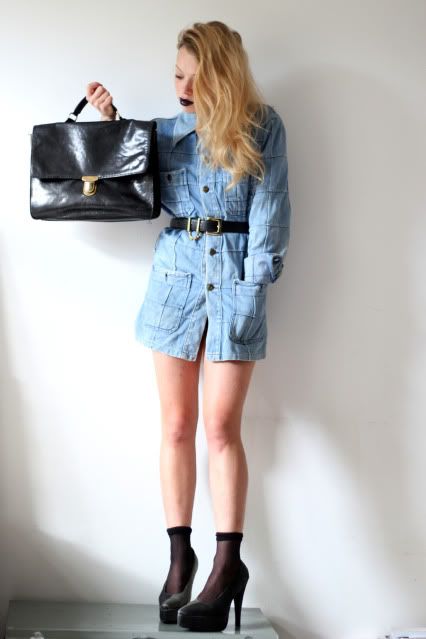

Thrifted 70's jacket worn as dress
Thrifted belt
Thrifted 90's platforms
Thrifted leather briefcase
Thrifted earrings
A musty smell of mold and dirty old laundry. Stained , weathered and worn down clothes. No friendly store girl offering her help. All the bad things from the 90’s; synthetic neon track jackets and tacky stretch jeans that gave who knows who a camel toe. For many, this is what comes to mind when thinking about charity or thrift stores.
To me it is paradise, a goldmine. High quality goodies for almost no money. There are still millions of unique garments out there in need of a new home. And my closet always has room for another fur coat, pair of 90s platforms or silk blouses from stylish grandma’s. Soon you’ll associate that stench of gym clothes and molded basement with gorgeous clothes. You’re going to like it so much that you won’t even bother to wash your finds before wearing them.
So how to find these garments, separate the trash from treasures and find that ‘lucky’ find? Every thrift store is packed with great finds. The key is to recognize and find beauty, it is everywhere.
1.Look for fabrics.
Those fugly neon track jackets might grab your attention so much that you overlook the black blouse in fine silk hanging right beside it. Try to discard everything you are not looking for from your view. Now, go through the racks or piles and look for prints, good quality denims, nice worn down leather, silk blouses or wool blazers. Ignore the fits and sizing. Start off by only looking at fabrics.
2.Fits
You now have a pile of garments in the right colors and materials. To make a selection on which clothes you are taking with you try to estimate the size and fit by viewing it. (Keep ignoring those size labels!) A ‘too small’ blazer for little boys could be a nice short and fitted blazer on you. A huge ‘too big’ grandpa blazer could be your next wool winter coat á la Yamamoto and Comme des Garçons. Vintage and secondhand clothes rarely fit according to their labels because they often come from another era or region.
3. Select
Try some things on, think of how they will look belted, look for stains and damages and make a selection. Keep in mind that the garment will look more polished after washing and ironing it. Also hit up accessory section, where for sizing applies one size fits(almost) all. Belts, bold 80s and 90s jewelry, antique jewelry, leather purses, silk scarves, brooches etcetera.
Alterations that could be made
-Too big trousers can be worn highwaisted and paperbaged at the top. Or cut short and then be worn like a highwaisted paperbag short.
-Too big dresses can be cut short, or easily be turned into a jumpsuit.
-Too short(or big) dresses can be cut in two so you’ll be left with a skirt + blouse.
The British clothing and textiles sector on its own currently produces around 3.1 million tons of CO2 per year, 70 million tons of waste water per year with 1.5 million tons of unwanted rest clothing per year. An average Japanese woman buys around 10 kilo’s of clothes and disposes around 9 kilo’s of clothes every year. 2.1 million tons of textile are disposed of in landfills every year. Fashions are becoming faster and the amount of clothes produced is out of proportions. There are enough clothes on the world already. Invest in well designed, high quality garments that will last or go thrifting and recycle. Allright enough with environmental activism, I guess its a result of watching too much Captain Planet back in the days.